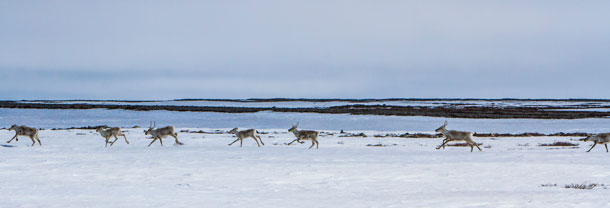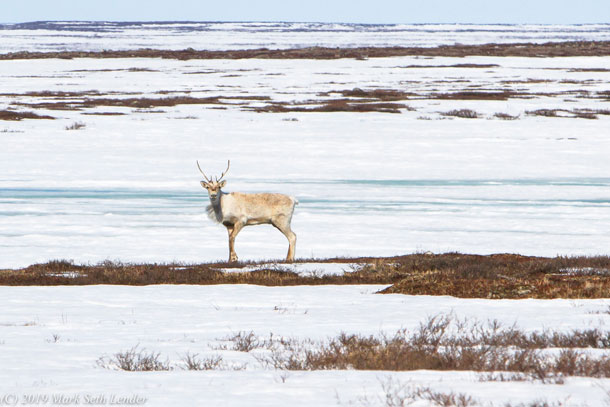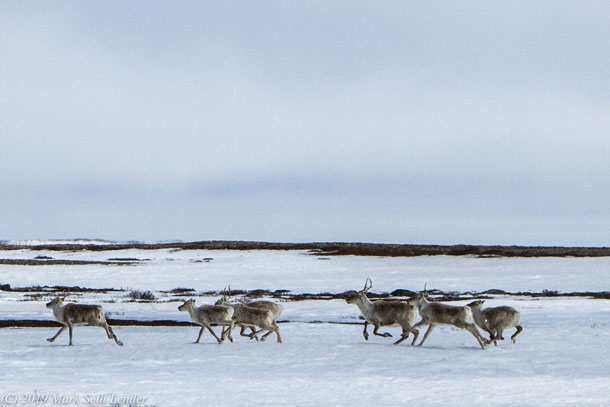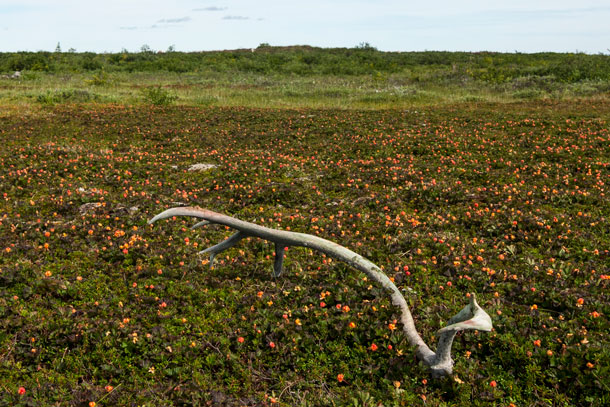Barren-Ground Caribou
Air Date: Week of January 3, 2020

Caribou running in the Arctic Snow. (Photo: Mark Seth Lender)
Living on Earth’s Explorer-in-Residence, Mark Seth Lender, recounts a visit to the Arctic during a summer season and describes how climate change has led to melting snow and ice there, creating challenges for the caribou.
Transcript
CURWOOD: Well, the holidays are wrapping up and Santa’s reindeer, or caribou, can take a break from the imaginations of children for another year. But Living on Earth’s Explorer in Residence, Mark Seth Lender, recently travelled to the Arctic to see herds of caribou on the move during the Arctic summer. He found climate change has led to melting snow and ice there, creating challenges for the caribou.
LENDER: Tundra by twilight is a thing of awe. And terror. It neither starts nor ends. White. Flat. Except for the piles of cobbles huge and strange and dark, each a flattened sphere fifty kilos and more, implicit of the immutable will that ground them into shape and carried them here and formed these standing barrows. Beautiful but not inviting. Nothing out here is inviting. The absence of night. The wind that comes in waves, and waves; snow corrugated into blue shadows and bright crests.

Picture of a female caribou. Caribou are the only deer in which males and females both have antlers. (Photo: Mark Seth Lender)
Lying low is not shelter.
There is no shelter.
We left first camp very early. The travel has been long and difficult. We cannot go any further. Tents are pitched for the night. We start to prepare something to eat, and meanwhile, melt ice for tea and stand around warming our hands on the cups. A wolf trots by. He is young. Unhurried and unwise he only glances at us, to him a passing curiosity. The Inuit do more than glance. Their eyes lock onto him. If they were not guiding us, if we were not here, they would shoot him.
“Have to,” Paul Pemik says, “or they’d kill off the caribou.”
I ask, “What happened before you were here to kill them?”
He thinks about that. “I don’t know. I guess they killed each other,” he says.
We see no more wolves.
The wind never stops.
I am too tired to sleep.
The very next morning there are caribou. Pemik, and Jason Curley, one kneeling one standing, are the first to spot them. Some shimmer of movement; a fine discontinuity in the texture of the horizon; only an eye trained from childhood would see it.

Caribou are migratory therefore very sensitive to changes in the landscape. Climate change plays a role by warming the Arctic ice and incrementing diseases and parasites which can kill off herds. (Photo: Mark Seth Lender)
We wait.
The caribou come up over the rise and into the narrow glacier-cut valley in single file. A small contingent of twenty, twenty-five at most, cows and their young of the previous year. The Inuit call them “scouts” because they precede the main migration and they are never shot. If they were harmed, the great moving mass of the Qamanirjuaq herd would be – somehow – informed. And turn away. And that would be the end of it because the hunters would never find them.
We don’t find them anyway.
Despite that a spotter plane went out ahead of us and gave this precise location. Despite all the ingrained history of caribou an Inuk hunter knows: where they cross lakes, ford rivers and streams, the likely routes between the piled stone barrows. It has been this way the last couple of years. Cold and miserable as it is, it is not cold enough. The komatik has been bouncing over patches of rock - jamming your knee joints if you don’t keep your muscles sprung, half knocking your teeth out if you don’t keep your mouth clamped shut - rock that should be under four feet of snow pack. But there is more to it than that. We have done more to the Arctic than warm it. It is not just the warmth to which the caribou object.

Caribou has been an essential part of the subsistence of the Inuit tribe. Caribou meat is high in protein, and caribou skin has been used to make art and clothing. (Photo: Mark Seth Lender)
The scouts, who have been watching us for a while (more wise than that lone wolf) break into a gallop. Though there is no leader or obvious leadership they hold to single file as they run. Then they slow and turn back. They are closer now, but not close. Not as close as they would have been had the Qamanirjuaq materialized, the bucks with their enormous antlers, all of them plodding in a near-trance and their wide camel-like hooves lifting, falling; the clicking of their ankles from which they take their Inuit name: Tuktu!
Instead of here, where they were supposed to be, 200,000 caribou came through three hundred kilometers away.
CURWOOD: That’s Living on Earth’s Explorer in Residence, Mark Seth Lender. For pictures, check out the living on earth website, LOE dot org.
Links
Living on Earth wants to hear from you!
Living on Earth
62 Calef Highway, Suite 212
Lee, NH 03861
Telephone: 617-287-4121
E-mail: comments@loe.org
Newsletter [Click here]
Donate to Living on Earth!
Living on Earth is an independent media program and relies entirely on contributions from listeners and institutions supporting public service. Please donate now to preserve an independent environmental voice.
NewsletterLiving on Earth offers a weekly delivery of the show's rundown to your mailbox. Sign up for our newsletter today!
 Sailors For The Sea: Be the change you want to sea.
Sailors For The Sea: Be the change you want to sea.
 The Grantham Foundation for the Protection of the Environment: Committed to protecting and improving the health of the global environment.
The Grantham Foundation for the Protection of the Environment: Committed to protecting and improving the health of the global environment.
 Contribute to Living on Earth and receive, as our gift to you, an archival print of one of Mark Seth Lender's extraordinary wildlife photographs. Follow the link to see Mark's current collection of photographs.
Contribute to Living on Earth and receive, as our gift to you, an archival print of one of Mark Seth Lender's extraordinary wildlife photographs. Follow the link to see Mark's current collection of photographs.
 Buy a signed copy of Mark Seth Lender's book Smeagull the Seagull & support Living on Earth
Buy a signed copy of Mark Seth Lender's book Smeagull the Seagull & support Living on Earth

